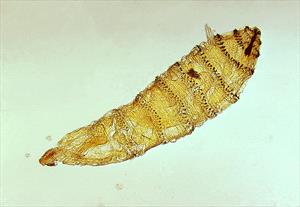Cuterebra

Photo courtesy of CDC/ Dr. George Healy
Cuterebriasis is caused by a fly called Cuterebra. The parasite infests small mammals that spend time outdoors, such as dogs, cats, rabbits, ferrets, squirrels, and rodents. Cuterebra are large non-feeding flies that lay eggs near animal burrows, nests, or vegetation. These opportunistic parasites do not seek out animals, but when an animal wanders by, in response to the host’s body heat the eggs attach and hatch. Infestation is most common in summer and fall.
Infestations of the skin tend to occur around the head and neck because the animal has stuck its head near a burrow that contains the eggs. Once a larva hatches, it can be licked and swallowed during grooming, enter the body via the mouth or nostrils, or it may enter through an open wound. The larva causes a lesion in subcutaneous (below skin) tissue. [See special note below.] The host acts like an incubator. The larva opens a tiny breathing hole (a fistula) in the skin. It just lives there, as though renting space; it does not feed on the host. An advanced-stage larva is the size of the first joint of your thumb and is a light tan color.
About a month after infestation, the Cuterebra larva crawls out of the skin to pupate and then emerge as an adult fly to begin the cycle. The length of time it stays in the ground depends on seasonal factors.
What pet owners typically see is the swelling at the air hole and matted hair from the pet’s over-grooming. Cats often groom to the point of irritation. Sometimes the pet has pain at the site. Some sites become infected and pus can be seen. Your veterinarian can diagnose cuterebriasis just by visual inspection.
Removing the larva is one of the simplest things in veterinary medicine; your veterinarian will probe and enlarge the breathing hole, grasp the parasite with forceps, and just pull the invader out. Squeezing the lesion with your fingers can rupture the larva and cause an infection. The larva should be removed as a whole piece, rather than in parts, in order to reduce the body’s reaction. Typically, no other treatment is required, although sometimes the wound will need to be flushed with saline, debrided (unhealthy tissue removed), or covered with antibiotic ointment. Because of the “housing” that was created around the subcutaneous parasite, it may take longer to heal than you might expect, but it will heal.
Special Note
The most common problem with Cuterebra is the subcutaneous site infestation. However, occasionally aberrant migration of Cuterebra spp. can occur in other tissues and can cause more significant disease.
Ophthalmomyiasis externa occurs when larvae infect the conjunctiva (the mucous membrane that lines the inner surface of the eyelids and is continued over the forepart of the eyeball), the skin around the eyes, and the eyelids.
Ophthalmomyiasis interna anterior occurs when larvae are in the anterior segment of the eye's globe.
Ophthalmomyiasis interna posterior occurs with larvae in the posterior segment.
Cuterebra spp. larvae have been found in the central nervous system (CNS) in some patients, leading to severe neurologic abnormalities. For example, cerebrospinal cuterebriasis has been associated with ischemic encephalopathy in cats.
Migration of larvae through the nose, trachea, pharynx, and larynx has also been reported. Other abnormalities, such as disseminated intravascular coagulation (DIC), systemic inflammatory response syndrome (SIRS), and protein losing nephropathy, have occurred in dogs.
All of these are very rare problems.